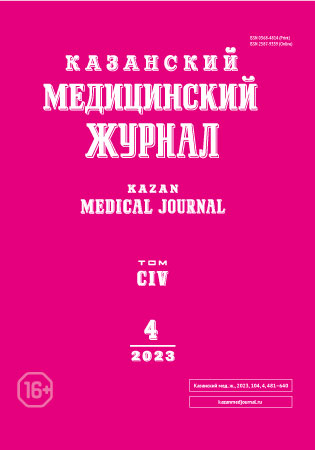Отдалённые результаты раннего ортодонтического лечения детей 3–5 лет
- Авторы: Шишмарева А.С.1, Бимбас Е.С.1
-
Учреждения:
- Уральский государственный медицинский университет
- Выпуск: Том 104, № 4 (2023)
- Страницы: 509-515
- Раздел: Теоретическая и клиническая медицина
- Статья получена: 27.10.2022
- Статья одобрена: 03.07.2023
- Статья опубликована: 24.07.2023
- URL: https://kazanmedjournal.ru/kazanmedj/article/view/112136
- DOI: https://doi.org/10.17816/KMJ112136
- ID: 112136
Цитировать
Полный текст
Аннотация
Актуальность. Частота зубочелюстных аномалий и тяжесть нарушений зубочелюстной системы у детей увеличиваются с возрастом. Раннее ортодонтическое лечение позволяет использовать преимущества роста и прорезывания зубов и приостановить патологическое развитие до того, как произойдут значительные компенсационные деформации зубочелюстной системы, которые сложнее поддаются лечению.
Цель. Изучить отдалённые результаты раннего ортодонтического лечения детей 3–5 лет.
Материал и методы исследования. Проведено проспективное исследование отдалённых результатов ортодонтического лечения у 50 детей в возрасте 3–5 лет. Проанализировано состояние зубочелюстной системы детей: величина диспропорции в сагиттальном, трансверзальном и вертикальном направлениях; направление и величина смещения нижней челюсти; наличие аномалий развития зубов до и через 3,5 года после лечения. Статистический анализ осуществлён с использованием программы Statistica 13.3. Применяли критерии Шапиро–Уилка, Колмогорова–Смирнова, показатели асимметрии и эксцесса, использовали тест Стьюдента.
Результаты. Выявлена высокая частота (52%) случаев тяжёлых нарушений окклюзии (нарушения окклюзии в двух плоскостях — 44%, в трёх — 8%). Часто встречалось смещение нижней челюсти — 72%. Указанные нарушения требуют раннего ортодонтического лечения. При анализе результатов раннего ортодонтического лечения через 3,5 года установлена физиологическая окклюзия в 86% случаев: уменьшение размера прямой сагиттальной щели (до лечения 3,9±2,5, после лечения 1,1±1,5; p=0,000005); устранение обратной сагиттальной щели (до лечения –0,8±0,5, после лечения 0,03±0,1; p=0,000000); уменьшение глубины вертикального перекрытия (до лечения 4,6±0,6, после лечения 2,2±1,1; p=0,000043); устранение вертикальной щели (до лечения 3,12±1,3, после лечения 1,0±2,0; p=0,05011); устранение экзоокклюзии (до лечения 4,9±2,3, после лечения 0,3±0,9, p=0,000000); устранение эндоокклюзии (до лечения 5,5±0,7, после лечения 0,7±0,3, p=0,033475); устранение смещения нижней челюсти. В 14% случаев у детей окклюзия не была идеальной, при этом было отмечено физиологическое развитие зубочелюстной системы.
Вывод. Раннее ортодонтическое лечение детей 3–5 лет позволяет устранить тяжёлые нарушения и в большинстве случаев создать условия для физиологического развития зубочелюстной системы.
Ключевые слова
Полный текст
Об авторах
Анастасия Сергеевна Шишмарева
Уральский государственный медицинский университет
Автор, ответственный за переписку.
Email: Dolphy2007@yandex.ru
ORCID iD: 0000-0001-8641-9088
SPIN-код: 1982-3790
канд. мед. наук, доц., каф. стоматологии детского возраста и ортодонтии
Россия, г. Екатеринбург, РоссияЕвгения Сергеевна Бимбас
Уральский государственный медицинский университет
Email: bimbases@gmail.com
ORCID iD: 0000-0003-4122-2518
докт. мед. наук, проф., каф. стоматологии детского возраста и ортодонтии
Россия, г. Екатеринбург, РоссияСписок литературы
- Арзуманян А.Г., Фомина А.В. Анализ распространённости и структуры зубочелюстных аномалий среди детей школьного возраста. Вестник новых медицинских технологий. 2019;(3):5–8. doi: 10.24411/1609-2163-2019-16239.
- Аюпова Ф.С., Восканян А.Р. Распространённость и структура зубочелюстных аномалий у детей (обзор литературы). Ортодонтия. 2016;(3):2–6. EDN: YZJUYH.
- Олесов Е.Е., Каганова О.С., Фазылова Т.А., Миргазизов М.З., Ильин А.А., Шугайлов И.А. Динамика структуры и тяжести зубочелюстных аномалий на фоне раннего ортодонтического лечения в период сменного прикуса. Клиническая практика. 2019;10(3):19–25. doi: 10.17816/clinpract10319-25.
- Zhou X, Zhang Y, Wang Y, Zhang H, Chen L, Liu Y. Prevalence of malocclusion in 3- to 5-year-old children in Shanghai, China. Int J Environ Res Public Health. 2017;14(3):328. doi: 10.3390/ijerph14030328.
- Проффит У.Р. Современная ортодонтия. Изд. 4-е. М.: МЕДпресс-информ; 2017. 560 с.
- Персин Л.С. Ортодонтия. Диагностика и лечение зубочелюстно-лицевых аномалий и деформаций. М.: ГЭОТАР-Медиа; 2016. 640 с.
- Шишмарева А.С., Бимбас Е.С., Мягкова Н.В., Шишмарева Ю.С. Ортодонтический аппарат для лечения мезиальной окклюзии со смещением нижней челюсти вперёд и обратным резцовым перекрытием у детей дошкольного возраста. Патент на полезную модель РФ №2019135381. Бюлл. №198418 U1 от 05.11.2019.
Дополнительные файлы









